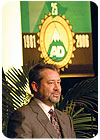It was 1981 when 48 distributors in the electrical industry started Affiliated Distributors. “Interest rates were high, and the chains were growing,” said A-D Chairman & CEO Bill Weisberg.
“The independents had good reason to be worried about their future in 1981. The gap between nationals and independents was large and it was widening. The top executives of the national chains were boasting of their success and their future growth plans. The leading experts of the day were predicting industry consolidation on a massive scale.
“And the nationals were growing,” he emphasized, “both through start-ups and through acquisition. The nationals were not better companies than independents, but they were successfully leveraging their purchasing clout with suppliers and they were cutting back-end deals that were not available to independents.”
Today's A-D numbers some 360 distributors spanning electrical, plumbing, PVF, HVAC and industrial supply divisions, with total sales of around $22 billion. The threats facing them are similar to those of 25 years ago. Weisberg, in his “State of the Industry” stem-winder speech closing the 2006 annual meeting of A-D's Plumbing & PVF Divisions, nonetheless exuded confidence in discussing the outlook for member firms.
Consolidation is raging once again, he said, yet: “Every time the national chains buy someone, our members in that market get stronger and realize accelerated growth. They pick up new customers that miss the flexibility and service levels that the acquired company no longer provides. They hire quality people that quickly become disillusioned about the new owners and the bureaucracy with which they operate. And they soak up market share like a sponge,” Weisberg stated.
“As I look to the future,” he continued, “I see an industry increasingly divided. To one side, stand a few giant distributors run from their corporate headquarters by financial managers without regard for their company's people, or their relationships with their long-time suppliers, and with little understanding of the realities of each local market. The executives at these companies have but one concern. It is the return they generate for their public or private equity masters.
“On the other side, stand a small army of strong independents. Some are family owned; some are employee owned. But all are professionally managed by people who have a deep commitment to their employees, their customers, their long-time suppliers and their local communities. And it is the independents who will be gaining share in their local markets, attracting new customers and hiring more and more of the best people in this industry,” said Weisberg.

Over-promising is okay
Some 600 members, suppliers and guests attended the 25th Anniversary meeting in mid-September of A-D's Plumbing/PVF Divisions at the plush Gaylord Texan Resort, about a runway's distance from the Dallas-Ft. Worth Airport. For the first time in A-D's history, the trade press was invited to attend and participate in selected programs.These included the keynote speech by marketing consultant Rick Barrera titled, “Over-promise, Over-deliver.” He said that to stand out from the crowd of competitors, a company needs to “articulate a brand promise and perform to the promise. Without an over-promise, you don't exist in the minds of customers,” said Barrera.
Three other educational workshops were available to the press on management topics, as well as an interactive workshop on PVF industry concerns that represented the highlight of the meeting to this reporter.
Raw materials top PVF concerns
PVF distributors and suppliers participated in an interactive workshop devoted to industry topics of their choice. The bulk of the discussion concerned the impact of escalating raw material prices in the PVF industry.First, the good news. It's one of our industry's dirty little secrets that rising prices benefit many distributors. Gross margin dollars are the lifeblood of distributors, and as long as they can maintain gross margin percentages, price increases mean more bucks flowing through their arteries.
Bad news is there are too many drawbacks to wild price gyrations for distributors to be jumping for joy. Here are some of the problems discussed by participants in the interactive PVF workshop.
People problems
Another topic that generated considerable discussion was the general business concern of finding and retaining good employees.One small distributor in the audience said that every one of his salespeople had come from the ranks of people hired as warehouse or delivery people. “You have to key in on your sharp people and work hard to keep them,” he said.
A consensus arose that the best employees tend to come from networking referrals rather than public advertising. The group also agreed with the contention by one person: “It's best to hire on the basis of character traits, not experience and skills.” You can always teach specific job skills to a person with the right attitude who is reliable and willing to learn.
Global sourcing
Time ran out before the PVF group got very deep into this complex topic. Limited discussion did focus on the thorny problem of knockoffs.One participant also ventured a rhetorical question wondering why so many end users are fussy about the pedigree of pipe and fittings, but barely questioned more complex valve products that are made around the world.
